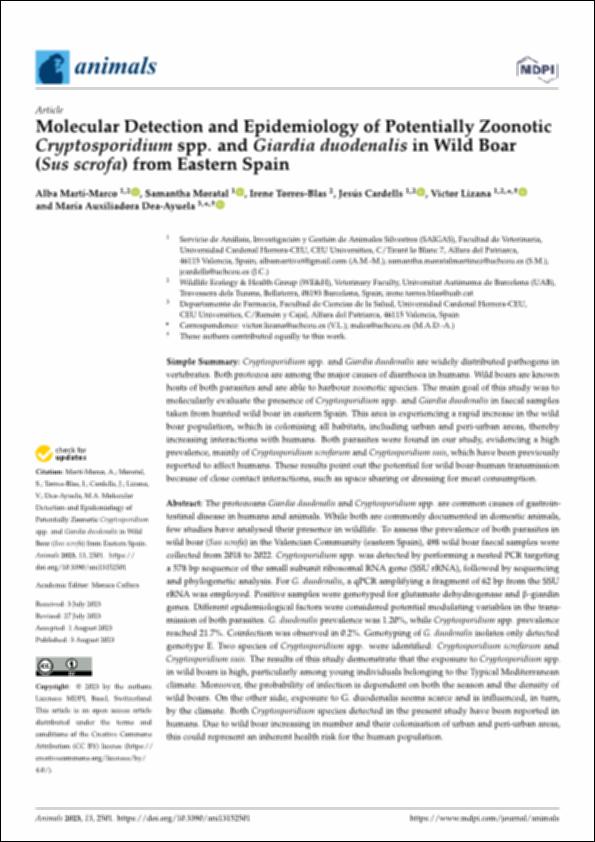Por favor, use este identificador para citar o enlazar este ítem:
http://hdl.handle.net/10637/15154Molecular detection and epidemiology of potentially zoonotic "Cryptosporidium spp." and "Giardia duodenalis" in Wild Boar (Sus scrofa) from Eastern Spain
| Título : | Molecular detection and epidemiology of potentially zoonotic "Cryptosporidium spp." and "Giardia duodenalis" in Wild Boar (Sus scrofa) from Eastern Spain |
| Autor : | Martí Marco, Alba Moratal, Samantha Torres Blas, Irene Cardells Peris, Jesús Lizana Martín, Víctor Manuel Dea Ayuela, María Auxiliadora |
| Materias: | Jabalíes; Wild Boar; Epidemiología; Epidemiology; España; Spain; Zoonosis; Zoonoses |
| Editorial : | MDPI |
| Citación : | Martí-Marco, A., Moratal, S., Torres-Blas, I., Cardells, J., Lizana, V. & Dea-Ayuela, M.A. (2023). Molecular detection and epidemiology of potentially zoonotic "Cryptosporidium spp." and "Giardia duodenalis" in Wild Boar (Sus scrofa) from Eastern Spain. Animals, vol. 13, i. 15, art. 2501 (03 aug.). DOI: https://doi.org/10.3390/ani13152501 |
| Resumen : | The protozoans Giardia duodenalis and Cryptosporidium spp. are common causes of gastrointestinal disease in humans and animals. While both are commonly documented in domestic animals, few studies have analysed their presence in wildlife. To assess the prevalence of both parasites in wild boar (Sus scrofa) in the Valencian Community (eastern Spain), 498 wild boar faecal samples were collected from 2018 to 2022. Cryptosporidium spp. was detected by performing a nested PCR targeting a 578 bp sequence of the small subunit ribosomal RNA gene (SSU rRNA), followed by sequencing and phylogenetic analysis. For G. duodenalis, a qPCR amplifying a fragment of 62 bp from the SSU rRNA was employed. Positive samples were genotyped for glutamate dehydrogenase and β-giardin genes. Different epidemiological factors were considered potential modulating variables in the transmission of both parasites. G. duodenalis prevalence was 1.20%, while Cryptosporidium spp. prevalence reached 21.7%. Coinfection was observed in 0.2%. Genotyping of G. duodenalis isolates only detected genotype E. Two species of Cryptosporidium spp. were identified: Cryptosporidium scrofarum and Cryptosporidium suis. The results of this study demonstrate that the exposure to Cryptosporidium spp. in wild boars is high, particularly among young individuals belonging to the Typical Mediterranean climate. Moreover, the probability of infection is dependent on both the season and the density of wild boars. On the other side, exposure to G. duodenalis seems scarce and is influenced, in turn, by the climate. Both Cryptosporidium species detected in the present study have been reported in humans. Due to wild boar increasing in number and their colonisation of urban and peri-urban areas, this could represent an inherent health risk for the human population. |
| URI : | http://hdl.handle.net/10637/15154 |
| Derechos: | Open Access http://creativecommons.org/licenses/by/4.0/deed.es |
| ISSN : | 2076-2615 (Electrónico) |
| Fecha de publicación : | 3-ago-2023 |
| Centro : | Universidad Cardenal Herrera-CEU |
| Aparece en las colecciones: | Dpto. Producción y Sanidad Animal, Salud Pública Veterinaria y Ciencia y Tecnología de los Alimentos |
Los ítems de DSpace están protegidos por copyright, con todos los derechos reservados, a menos que se indique lo contrario.


